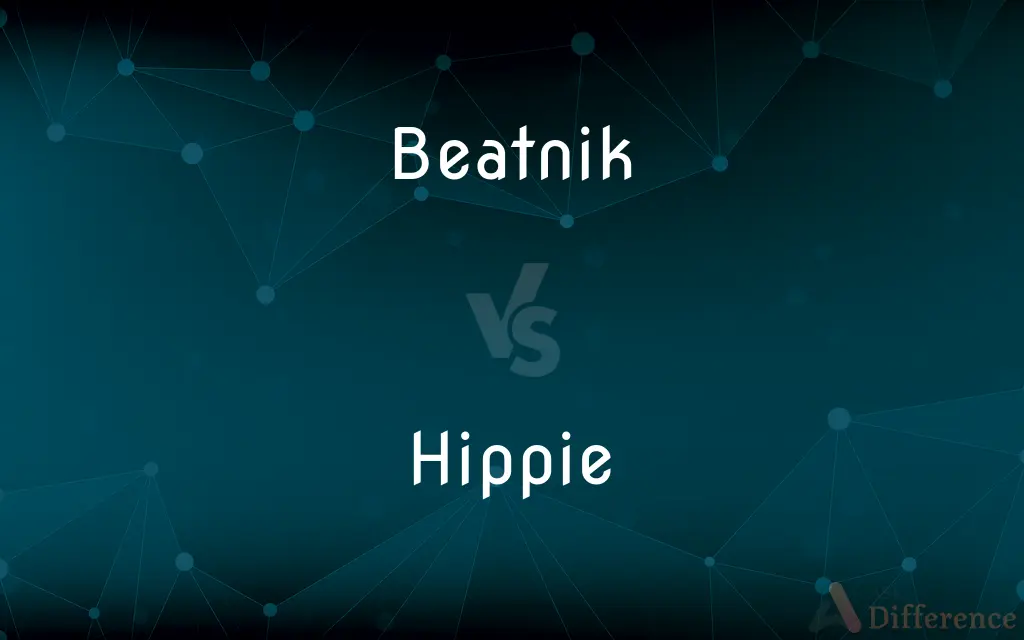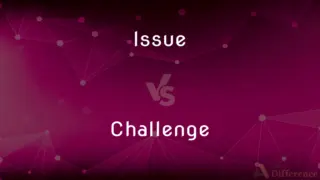Beatnik vs. Hippie — What's the Difference?
Edited by Tayyaba Rehman — By Fiza Rafique — Updated on March 28, 2024
Beatniks were part of a cultural movement in the 1950s, known for their rejection of conventional society and embrace of artistic expression, while hippies emerged in the 1960s, advocating for peace, love, and communal living, alongside to war.

Difference Between Beatnik and Hippie
Table of Contents
ADVERTISEMENT
Key Differences
Beatniks, emerging in the late 1950s, were closely associated with the Beat Generation of writers and poets who challenged the mainstream norms and materialism of post-World War II society through their works. They were known for their interest in jazz, poetry readings, and a bohemian lifestyle, often congregating in coffee shops and bars, particularly in San Francisco and New York City. In contrast, hippies, rising to prominence in the mid-1960s, were part of a youth movement that opposed the Vietnam War and the political and social orthodoxy of the time. They are often remembered for their iconic music festivals, like Woodstock, psychedelic art, and the widespread use of recreational drugs to explore altered states of consciousness.
While beatniks were characterized by their dark clothing, turtlenecks, and berets, embracing a more intellectual and minimalist aesthetic, hippies preferred colorful, flowery clothing, long hair, and beads, reflecting their ideals of peace and love. The beatnik movement placed a strong emphasis on literary achievements and was influenced by jazz, whereas the hippie movement had a significant impact on music, giving rise to the psychedelic rock genre and legendary bands like The Grateful Dead and Jefferson Airplane.
The societal impact of beatniks was more subtle, primarily influencing literature and encouraging a critical examination of society's values. Hippies, however, were more visibly active in political and social movements, including civil rights, environmentalism, and women's liberation, leaving a lasting legacy on various social policies and cultural norms.
Both movements sought freedom from societal constraints but approached their rebellion in different manners. Beatniks delved into the depths of the mind and art for liberation, while hippies also sought to change the world around them through activism and an alternative lifestyle.
Comparison Chart
Era
1950s
1960s
ADVERTISEMENT
Origins
Beat Generation writers
Youth movement against war and for civil liberties
Key Influences
Jazz, existentialism
Psychedelic rock, Eastern philosophy
Fashion
Dark clothing, turtlenecks, berets
Colorful, flowery clothing, beads, long hair
Values
Artistic expression, non-conformity
Peace, love, communal living, anti-war
Notable Activities
Poetry readings, jazz clubs
Music festivals, protests, communal living
Societal Impact
Literary and artistic influence, critique of materialism
Political activism, influence on music, art, and social policies
Compare with Definitions
Beatnik
Minimalist aesthetic.
Their fashion included black turtlenecks and berets, symbolizing a departure from mainstream styles.
Hippie
Advocacy for peace and love.
Hippies organized protests against the Vietnam War, promoting peace and communal living.
Beatnik
Influenced by jazz.
Jazz music played a significant role in beatnik culture, influencing their expressions of freedom.
Hippie
Psychedelic influence.
Their culture was marked by psychedelic art and music, exploring consciousness and spirituality.
Beatnik
Coffee shop culture.
They were known for their gatherings in coffee shops, where intellectual debates and poetry readings were common.
Hippie
Music festivals.
Woodstock became a symbol of hippie culture, showcasing their influence on music and society.
Beatnik
Literary contributions.
Beatniks, such as Jack Kerouac, contributed seminal works that challenged conventional narratives.
Hippie
Legacy in social movements.
Hippies contributed to the advancement of environmentalism, civil rights, and women's liberation.
Beatnik
Focus on intellectual and artistic rebellion.
Beatniks gathered in coffee shops to discuss poetry and jazz, showcasing their disdain for societal norms.
Hippie
Iconic fashion.
Hippies wore colorful clothing, embodying their ideals of freedom and harmony with nature.
Beatnik
Beatnik was a media stereotype prevalent throughout the late 1940s, 1950s to mid-1960s that displayed the more superficial aspects of the Beat Generation literary movement of the late 1940s and early to mid 1950s. Elements of the beatnik trope included pseudo-intellectualism, drug use, and a cartoonish depiction of real-life people along with the spiritual quest of Jack Kerouac's autobiographical fiction.
Hippie
A hippie, also spelled as hippy, is a member of the counterculture of the 1960s, originally a youth movement that began in the United States during the mid-1960s and spread to other countries around the world. The word hippie came from hipster and was used to describe beatniks who moved into New York City's Greenwich Village, San Francisco's Haight-Ashbury district, and Chicago's Old Town community.
Beatnik
A person, especially a member or follower of the Beat Generation, whose behavior, views, and often style of dress are pointedly unconventional.
Hippie
(1950s slang) A teenager who imitated the beatniks.
Beatnik
A person who dresses in a manner that is not socially acceptable and is supposed to reject conventional norms of thought and behavior; nonconformist in dress and behavior.
Hippie
(modern slang) A person who keeps an unkempt or sloppy appearance and has unusually long hair (for males), and is thus often stereotyped as a deadbeat.
Beatnik
A person associated with the Beat Generation of the 1950s and 1960s or its style.
Hippie
Someone who dresses in a hippie style.
Beatnik
A member of the Beat Generation; a nonconformist in dress and behavior.
Hippie
One who is hip.
Beatnik
A member of the beat generation; a nonconformist in dress and behavior
Hippie
Of or pertaining to hippies.
That dress looks very hippie.
Hippie
Not conforming to generally accepted standards.
They used a bunch of hippie compression formats instead of the usual RAR and ZIP.
Hippie
Someone who rejects the established culture, dresses casually, and advocates extreme liberalism in politics and lifestyle. Used especially of those in the late 1960's, mostly in their late teens and early twenties, who conspicuously rejected traditional culture by dressing casually, if male wore their hair long, and wore folksy or used clothing adorned with beads, headbands, and often flowers; they emphasized the importance of love and direct personal relations rather than success-oriented businesslike behavior, strove for spontaneity, sometimes lived communally, and in some cases tried to expand their consciousness by various psychological techniques such as meditation, or through the use of consciousness-altering drugs such as marijuana or LSD. By the end of the Vietnam war in the 1970's, the numbers of people living a visibly hippie lifestyle had dramatically decreased, though some people continue to develop similar views and live with the same outlook.
Hippie
Someone who rejects the established culture; advocates extreme liberalism in politics and lifestyle
Common Curiosities
How did hippies impact society?
Hippies had a profound impact on society through their involvement in anti-war protests, environmentalism, and the civil rights movement, as well as their influence on music, art, and fashion, challenging traditional values and promoting a culture of peace and love.
How did the fashion of beatniks and hippies reflect their values?
Beatnik fashion, with its dark, minimalist aesthetic, reflected their intellectual rebellion and rejection of mainstream consumerism. Hippie fashion, characterized by colorful and flowery clothing, symbolized their ideals of peace, love, and connection to nature.
Were beatniks and hippies politically active?
Beatniks were more focused on artistic and intellectual rebellion, with less emphasis on direct political activism. In contrast, hippies were actively involved in political movements, especially in opposition to the Vietnam War and in support of civil liberties.
Can beatniks and hippies be considered part of the same continuum of cultural rebellion?
While distinct in their origins, influences, and expressions, beatniks and hippies can be seen as part of a broader continuum of cultural rebellion against the mainstream norms of their respective eras, with the beatnik movement laying some of the intellectual groundwork that influenced the hippie movement.
What led to the emergence of beatniks?
The beatnik movement emerged as a reaction to the conservative norms and materialism of post-World War II society, influenced by the Beat Generation's literary exploration of existential angst and rejection of societal constraints.
What is the legacy of the beatnik and hippie movements today?
The legacy of the beatnik and hippie movements can be seen in contemporary society's ongoing discussions around individual freedom, social justice, and environmental sustainability. They helped pave the way for future generations to challenge societal norms, inspired innovations in art and music, and contributed to a more open dialogue on issues such as war, civil rights, and the importance of personal and spiritual growth.
How did the beatnik and hippie movements view the role of spirituality?
Beatniks generally embraced existentialism, exploring the meaning of life and the individual's place in the universe through literature and philosophy. Hippies often sought spiritual enlightenment through Eastern philosophies, psychedelic experiences, and a deep connection with nature, reflecting a more overt pursuit of spiritual fulfillment.
What were the major differences between beatnik and hippie music influences?
Beatniks were heavily influenced by jazz, seeing it as a symbol of artistic freedom and rebellion against conventional norms. Hippies, on the other hand, were associated with psychedelic rock and folk music, which embodied their ideals of peace, love, and communal living, and served as a form of protest against the Vietnam War and societal injustices.
Did beatniks and hippies contribute to the evolution of literature and art?
Yes, both movements made significant contributions to literature and art. Beatniks, through their poetry and novels, challenged traditional forms and themes, pushing the boundaries of expression and content. Hippies influenced visual art, music, and literature with their psychedelic aesthetic, themes of liberation, and experimentation with form and substance, leaving a lasting legacy in the cultural landscape.
How did society at large react to beatniks and hippies?
Both beatniks and hippies were met with skepticism and opposition from mainstream society, which often viewed them as threats to conventional values and social order. Beatniks were criticized for their non-conformist attitudes and lifestyles, while hippies faced backlash for their anti-war activism, drug use, and radical departure from traditional norms. Over time, however, aspects of both movements have been assimilated into broader cultural and social understandings.
Share Your Discovery

Previous Comparison
Issue vs. Challenge
Next Comparison
Jazz vs. RockAuthor Spotlight
Written by
Fiza RafiqueFiza Rafique is a skilled content writer at AskDifference.com, where she meticulously refines and enhances written pieces. Drawing from her vast editorial expertise, Fiza ensures clarity, accuracy, and precision in every article. Passionate about language, she continually seeks to elevate the quality of content for readers worldwide.
Edited by
Tayyaba RehmanTayyaba Rehman is a distinguished writer, currently serving as a primary contributor to askdifference.com. As a researcher in semantics and etymology, Tayyaba's passion for the complexity of languages and their distinctions has found a perfect home on the platform. Tayyaba delves into the intricacies of language, distinguishing between commonly confused words and phrases, thereby providing clarity for readers worldwide.















































